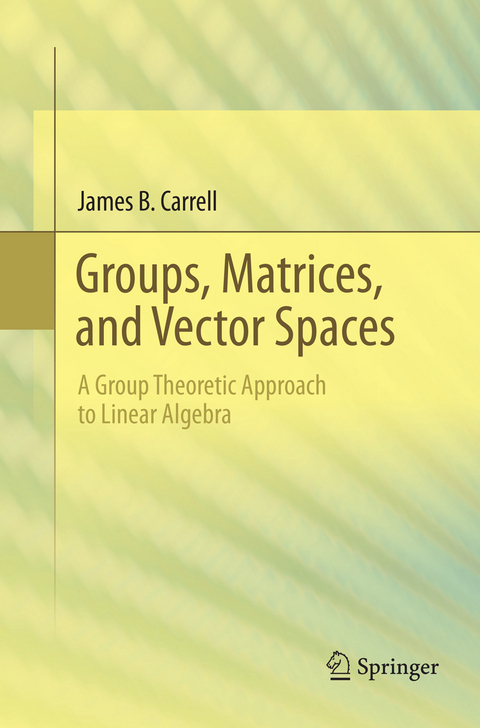
Groups, Matrices, and Vector Spaces
A Group Theoretic Approach to Linear Algebra
Seiten
2018
|
Softcover reprint of the original 1st ed. 2017
Springer-Verlag New York Inc.
978-1-4939-7910-3 (ISBN)
Springer-Verlag New York Inc.
978-1-4939-7910-3 (ISBN)
The final two chapters consist of a more intensive look at group theory, emphasizing orbit stabilizer methods, and an introduction to linear algebraic groups, which enriches the notion of a matrix group.
Applications involving symm
etry groups, determinants, linear coding theory and cryptography are interwoven throughout.
This unique text provides a geometric approach to group theory and linear algebra, bringing to light the interesting ways in which these subjects interact. Requiring few prerequisites beyond understanding the notion of a proof, the text aims to give students a strong foundation in both geometry and algebra. Starting with preliminaries (relations, elementary combinatorics, and induction), the book then proceeds to the core topics: the elements of the theory of groups and fields (Lagrange's Theorem, cosets, the complex numbers and the prime fields), matrix theory and matrix groups, determinants, vector spaces, linear mappings, eigentheory and diagonalization, Jordan decomposition and normal form, normal matrices, and quadratic forms. The final two chapters consist of a more intensive look at group theory, emphasizing orbit stabilizer methods, and an introduction to linear algebraic groups, which enriches the notion of a matrix group.
Applications involving symm
etry groups, determinants, linear coding theory and cryptography are interwoven throughout. Each section ends with ample practice problems assisting the reader to better understand the material. Some of the applications are illustrated in the chapter appendices. The author's unique melding of topics evolved from a two semester course that he taught at the University of British Columbia consisting of an undergraduate honors course on abstract linear algebra and a similar course on the theory of groups. The combined content from both makes this rare text ideal for a year-long course, covering more material than most linear algebra texts. It is also optimal for independent study and as a supplementary text for various professional applications. Advanced undergraduate or graduate students in mathematics, physics, computer science and engineering will find this book both useful and enjoyable.
Applications involving symm
etry groups, determinants, linear coding theory and cryptography are interwoven throughout.
This unique text provides a geometric approach to group theory and linear algebra, bringing to light the interesting ways in which these subjects interact. Requiring few prerequisites beyond understanding the notion of a proof, the text aims to give students a strong foundation in both geometry and algebra. Starting with preliminaries (relations, elementary combinatorics, and induction), the book then proceeds to the core topics: the elements of the theory of groups and fields (Lagrange's Theorem, cosets, the complex numbers and the prime fields), matrix theory and matrix groups, determinants, vector spaces, linear mappings, eigentheory and diagonalization, Jordan decomposition and normal form, normal matrices, and quadratic forms. The final two chapters consist of a more intensive look at group theory, emphasizing orbit stabilizer methods, and an introduction to linear algebraic groups, which enriches the notion of a matrix group.
Applications involving symm
etry groups, determinants, linear coding theory and cryptography are interwoven throughout. Each section ends with ample practice problems assisting the reader to better understand the material. Some of the applications are illustrated in the chapter appendices. The author's unique melding of topics evolved from a two semester course that he taught at the University of British Columbia consisting of an undergraduate honors course on abstract linear algebra and a similar course on the theory of groups. The combined content from both makes this rare text ideal for a year-long course, covering more material than most linear algebra texts. It is also optimal for independent study and as a supplementary text for various professional applications. Advanced undergraduate or graduate students in mathematics, physics, computer science and engineering will find this book both useful and enjoyable.
James B. Carrell is Professor Emeritus of mathematics at the University of British Columbia. His research areas include algebraic transformation groups, algebraic geometry, and Lie theory.
1. Preliminaries.- 2. Groups and Fields: The Two Fundamental Notions of Algebra.- 3. Vector Spaces.- 4. Linear Mappings.- 5. Eigentheory.- 6. Unitary Diagonalization and Quadratic Forms.- 7. The Structure Theory of Linear Mappings.- 8. Theorems on Group Theory.- 9. Linear Algebraic Groups: An Introduction.- Bibliography.- Index.
| Erscheint lt. Verlag | 3.8.2018 |
|---|---|
| Zusatzinfo | XVII, 410 p. |
| Verlagsort | New York |
| Sprache | englisch |
| Maße | 155 x 235 mm |
| Themenwelt | Mathematik / Informatik ► Mathematik ► Algebra |
| Mathematik / Informatik ► Mathematik ► Geometrie / Topologie | |
| ISBN-10 | 1-4939-7910-8 / 1493979108 |
| ISBN-13 | 978-1-4939-7910-3 / 9781493979103 |
| Zustand | Neuware |
| Informationen gemäß Produktsicherheitsverordnung (GPSR) | |
| Haben Sie eine Frage zum Produkt? |
Mehr entdecken
aus dem Bereich
aus dem Bereich
Buch | Softcover (2022)
Springer Spektrum (Verlag)
CHF 55,95


